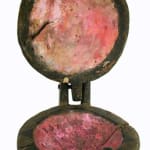Yoruba Wooden Divination Bowl, 20th Century CE
Wood
21.6 x 41.9 x 24.1 cm
8 1/2 x 16 1/2 x 9 1/2 in
8 1/2 x 16 1/2 x 9 1/2 in
X.0600
Further images
The Yoruba people, numbering over eighteen million, are one of the best known and most artistically prolific tribes of Sub-Saharan Africa. They are centered in southwestern Nigeria, with a significant...
The Yoruba people, numbering over eighteen million, are one of the best known and most artistically prolific tribes of Sub-Saharan Africa. They are centered in southwestern Nigeria, with a significant population extending into the neighboring Republic of Benin. In addition, many people in both North and South America claim Yoruban ancestry, a result of the Atlantic slave trade. Although Yoruban peoples have long referred to themselves by specific group names based on the towns they inhabit, they are all united by the Yoruba language, a common mythology, and related artistic styles, suggesting there is a common identity linking all the people. Historically, the Yoruba lived in politically centralized city-states, the most famous of which are Ife (the mythological nexus of creation), Owo, and Oyo (from which the name Yoruba was derived by missionaries). Yoruba art is now designated by the name of the geographic locale a particular group inhabited. Some individual artists and workshops have also been identified. The Yoruba are famed for their beadwork, which was used to decorate attributes of kings, including foot rests, crowns, and cloaks. Other major art forms include textiles, figurative implements used by herbalists and diviners, small figures carved to honor deceased twins (called ibeji dolls), cast copper-alloy ritual objects, as well as decorative stools and veranda posts that would have belonged to the king.
The Yoruba are the largest of all the sculpture producing tribes of Africa. Besides a great variety of local cults, Yoruba religion and art are characterized by a number of universal cults of major deities who began as nature gods. People of ancient Nigeria built shrines to worship these gods, and the shrines were elaborately decorated and furnished with various sculptural objects. This beautiful wood carving of a horse and rider with a bowl resting upon his head is a fine example of such shrine sculptures. Such bowls usually contained symbolic objects such as Neolithic celts or sacred palm nuts that were used in rituals and rites. The lid covering the bowl is still attached to the work, decorated with the image of a nude woman with her limbs akimbo, suggesting that this bowl may have had a fertility connotation. Inside, there is a layer of pink colored ritual residue that proves it was once utilized in religious ceremonies. The base of the bowl depicts a horse and rider surrounded by smaller kneeling attendants. The rider is a distinguished man with a prominent beard and decorative facial scars that were also marks of prestige. He carries the reigns in his left hand, confidently guiding the mighty steed, and in his right, a sword that symbolizes his authority. A smaller figure sits in front of the rider, leaning into the horse like a jockey. On the back of the steed, a kneeling female figure is present, markedly larger in scale than the kneeling attendants (scale is often a sign of ranking importance in art). She holds an infant in her arms that suckled on her breast. As we look at this beautiful sculpture that once contained magical substances, we are taking a glimpse of the ancient shrine that was filled with spiritual power.
The Yoruba are the largest of all the sculpture producing tribes of Africa. Besides a great variety of local cults, Yoruba religion and art are characterized by a number of universal cults of major deities who began as nature gods. People of ancient Nigeria built shrines to worship these gods, and the shrines were elaborately decorated and furnished with various sculptural objects. This beautiful wood carving of a horse and rider with a bowl resting upon his head is a fine example of such shrine sculptures. Such bowls usually contained symbolic objects such as Neolithic celts or sacred palm nuts that were used in rituals and rites. The lid covering the bowl is still attached to the work, decorated with the image of a nude woman with her limbs akimbo, suggesting that this bowl may have had a fertility connotation. Inside, there is a layer of pink colored ritual residue that proves it was once utilized in religious ceremonies. The base of the bowl depicts a horse and rider surrounded by smaller kneeling attendants. The rider is a distinguished man with a prominent beard and decorative facial scars that were also marks of prestige. He carries the reigns in his left hand, confidently guiding the mighty steed, and in his right, a sword that symbolizes his authority. A smaller figure sits in front of the rider, leaning into the horse like a jockey. On the back of the steed, a kneeling female figure is present, markedly larger in scale than the kneeling attendants (scale is often a sign of ranking importance in art). She holds an infant in her arms that suckled on her breast. As we look at this beautiful sculpture that once contained magical substances, we are taking a glimpse of the ancient shrine that was filled with spiritual power.







